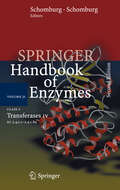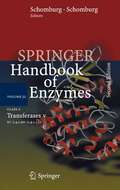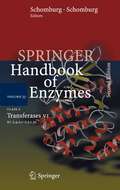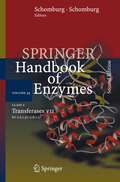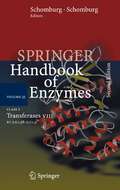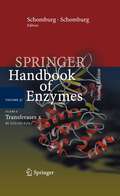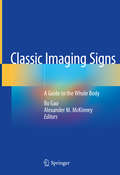- Table View
- List View
Class 2 Transferases IV: EC 2.4.1.1 - 2.4.1.89 (Springer Handbook of Enzymes #31)
by A. ChangThe Springer Handbook of Enzymes provides concise data on some 5,000 enzymes sufficiently well characterized – and here is the second, updated edition. Their application in analytical, synthetic and biotechnology processes as well as in food industry, and for medicinal treatments is added. Data sheets are arranged in their EC-Number sequence. The new edition reflects considerable progress in enzymology: the total material has more than doubled, and the complete 2nd edition consists of 39 volumes plus Synonym Index. Starting in 2009, all newly classified enzymes are treated in Supplement Volumes.
Class 2 . Transferases IX: EC 2.7.1.38 - 2.7.1.112 (Springer Handbook of Enzymes #36)
by A. ChangThe Springer Handbook of Enzymes provides concise data on some 5,000 enzymes sufficiently well characterized – and here is the second, updated edition. Their application in analytical, synthetic and biotechnology processes as well as in food industry, and for medicinal treatments is added. Data sheets are arranged in their EC-Number sequence. The new edition reflects considerable progress in enzymology: the total material has more than doubled, and the complete 2nd edition consists of 39 volumes plus Synonym Index. Starting in 2009, all newly classified enzymes are treated in Supplement Volumes.
Class 2 Transferases V: 2.4.1.90 - 2.4.1.232 (Springer Handbook of Enzymes #32)
by A. ChangThe Springer Handbook of Enzymes provides concise data on some 5,000 enzymes sufficiently well characterized – and here is the second, updated edition. Their application in analytical, synthetic and biotechnology processes as well as in food industry, and for medicinal treatments is added. Data sheets are arranged in their EC-Number sequence. The new edition reflects considerable progress in enzymology: the total material has more than doubled, and the complete 2nd edition consists of 39 volumes plus Synonym Index. Starting in 2009, all newly classified enzymes are treated in Supplement Volumes.
Class 2 Transferases VI: 2.4.2.1 - 2.5.1.30 (Springer Handbook of Enzymes #33)
by A. ChangThe Springer Handbook of Enzymes provides concise data on some 5,000 enzymes sufficiently well characterized – and here is the second, updated edition. Their application in analytical, synthetic and biotechnology processes as well as in food industry, and for medicinal treatments is added. Data sheets are arranged in their EC-Number sequence. The new edition reflects considerable progress in enzymology: the total material has more than doubled, and the complete 2nd edition consists of 39 volumes plus Synonym Index. Starting in 2009, all newly classified enzymes are treated in Supplement Volumes.
Class 2 Transferases VII: EC 2.5.1.31 - 2.6.1.57 (Springer Handbook of Enzymes #34)
by A. ChangThe Springer Handbook of Enzymes provides concise data on some 5,000 enzymes sufficiently well characterized – and here is the second, updated edition. Their application in analytical, synthetic and biotechnology processes as well as in food industry, and for medicinal treatments is added. Data sheets are arranged in their EC-Number sequence. The new edition reflects considerable progress in enzymology: the total material has more than doubled, and the complete 2nd edition consists of 39 volumes plus Synonym Index. Starting in 2009, all newly classified enzymes are treated in Supplement Volumes.
Class 2 Transferases VIII: EC 2.6.1.58 - 2.7.1.37 (Springer Handbook of Enzymes #35)
by A. ChangThe Springer Handbook of Enzymes provides concise data on some 5,000 enzymes sufficiently well characterized – and here is the second, updated edition. Their application in analytical, synthetic and biotechnology processes as well as in food industry, and for medicinal treatments is added. Data sheets are arranged in their EC-Number sequence. The new edition reflects considerable progress in enzymology: the total material has more than doubled, and the complete 2nd edition consists of 39 volumes plus Synonym Index. Starting in 2009, all newly classified enzymes are treated in Supplement Volumes.
Class 2 Transferases X: EC 2.7.1.113 - 2.7.5.7 (Springer Handbook of Enzymes #37)
by A. ChangThe Springer Handbook of Enzymes provides concise data on some 5,000 enzymes sufficiently well characterized – and here is the second, updated edition. Their application in analytical, synthetic and biotechnology processes as well as in food industry, and for medicinal treatments is added. Data sheets are arranged in their EC-Number sequence. The new edition reflects considerable progress in enzymology: the total material has more than doubled, and the complete 2nd edition consists of 39 volumes plus Synonym Index. Starting in 2009, all newly classified enzymes are treated in Supplement Volumes.
Class 2 Transferases XI: EC 2.7.6 - 2.7.7 (Springer Handbook of Enzymes #38)
by Antje ChangThe Springer Handbook of Enzymes provides concise data on some 5,000 enzymes sufficiently well characterized – and here is the second, updated edition. Their application in analytical, synthetic and biotechnology processes as well as in food industry, and for medicinal treatments is added. Data sheets are arranged in their EC-Number sequence. The new edition reflects considerable progress in enzymology: the total material has more than doubled, and the complete 2nd edition consists of 39 volumes plus Synonym Index. Starting in 2009, all newly classified enzymes are treated in Supplement Volumes.
Class 2 Transferases XII: EC 2.7.8 - 2.9.1 (Springer Handbook of Enzymes #39)
by A. ChangThe Springer Handbook of Enzymes provides concise data on some 5,000 enzymes sufficiently well characterized – and here is the second, updated edition. Their application in analytical, synthetic and biotechnology processes as well as in food industry, and for medicinal treatments is added. Data sheets are arranged in their EC-Number sequence. The new edition reflects considerable progress in enzymology: the total material has more than doubled, and the complete 2nd edition consists of 39 volumes plus Synonym Index. Starting in 2009, all newly classified enzymes are treated in Supplement Volumes.
Class 2–3.2 Transferases, Hydrolases: EC 2–3.2 (Springer Handbook of Enzymes #9)
by Dietmar Schomburg Ida Schomburg Antje ChangSpringer Handbook of Enzymes provides data on enzymes sufficiently well characterized. It offers concise and complete descriptions of some 5,000 enzymes and their application areas. Data sheets are arranged in their EC-Number sequence and the volumes themselves are arranged according to enzyme classes. This new, second edition reflects considerable progress in enzymology: many enzymes are newly classified or reclassified. Each entry is correlated with references and one or more source organisms. New datafields are created: application and engineering (for the properties of enzymes where the sequence has been changed). The total amount of material contained in the Handbook has more than doubled so that the complete second edition consists of 39 volumes as well as a Synonym Index. In addition, starting in 2009, all newly classified enzymes are treated in Supplement Volumes. Springer Handbook of Enzymes is an ideal source of information for researchers in biochemistry, biotechnology, organic and analytical chemistry, and food sciences, as well as for medicinal applications.
Class 3.4–6 Hydrolases, Lyases, Isomerases, Ligases: EC 3.4–6 (Springer Handbook of Enzymes #10)
by Dietmar Schomburg Ida Schomburg Antje ChangSpringer Handbook of Enzymes provides data on enzymes sufficiently well characterized. It offers concise and complete descriptions of some 5,000 enzymes and their application areas. Data sheets are arranged in their EC-Number sequence and the volumes themselves are arranged according to enzyme classes. This new, second edition reflects considerable progress in enzymology: many enzymes are newly classified or reclassified. Each entry is correlated with references and one or more source organisms. New datafields are created: application and engineering (for the properties of enzymes where the sequence has been changed). The total amount of material contained in the Handbook has more than doubled so that the complete second edition consists of 39 volumes as well as a Synonym Index. In addition, starting in 2009, all newly classified enzymes are treated in Supplement Volumes. Springer Handbook of Enzymes is an ideal source of information for researchers in biochemistry, biotechnology, organic and analytical chemistry, and food sciences, as well as for medicinal applications.
Class 3 Hydrolases: EC 3.4.22-3.13 (Springer Handbook of Enzymes #S6)
by Antje ChangThe Springer Handbook of Enzymes provides concise data on some 5,000 enzymes sufficiently well characterized – and here is the second, updated edition. Their application in analytical, synthetic and biotechnology processes as well as in food industry, and for medicinal treatments is added. Data sheets are arranged in their EC-Number sequence. The new edition reflects considerable progress in enzymology: the total material has more than doubled, and the complete 2nd edition consists of 39 volumes plus Synonym Index. Starting in 2009, all newly classified enzymes are treated in Supplement Volumes.
Class 3 Hydrolases: EC 3.1-3.4.21 (Springer Handbook of Enzymes #S5)
by Antje ChangThe Springer Handbook of Enzymes provides concise data on some 5,000 enzymes sufficiently well characterized – and here is the second, updated edition. Their application in analytical, synthetic and biotechnology processes as well as in food industry, and for medicinal treatments is added. Data sheets are arranged in their EC-Number sequence. The new edition reflects considerable progress in enzymology: the total material has more than doubled, and the complete 2nd edition consists of 39 volumes plus Synonym Index. Starting in 2009, all newly classified enzymes are treated in Supplement Volumes.
Class 4-6 Lyases, Isomerases, Ligases: EC 4-6 (Springer Handbook of Enzymes #S7)
by Antje ChangThe Springer Handbook of Enzymes provides concise data on some 5,000 enzymes sufficiently well characterized – and here is the second, updated edition. Their application in analytical, synthetic and biotechnology processes as well as in food industry, and for medicinal treatments is added. Data sheets are arranged in their EC-Number sequence. The new edition reflects considerable progress in enzymology: the total material has more than doubled, and the complete 2nd edition consists of 39 volumes plus Synonym Index. Starting in 2009, all newly classified enzymes are treated in Supplement Volumes.
Class Struggle and Social Welfare (The\state Of Welfare Ser.)
by Michael Lavalette Gerry MooneyFor too long the collective struggles of the oppressed over welfare provision and welfare settlement have been ignored, yet such struggles punctuate recent British history. By presenting a series of case-studies of episodes of collective action from the field of social policy and social welfare, Class Struggle and Welfare aims to rediscover this 'hidden history'. Organised chronologically, the book covers some of the most important welfare struggles from the early nineteenth century, some of the issues covered are: *the growth of capitalism *the development of the poor laws and the anti-poor law movement *working class self-help welfare in the nineteenth century *rent strikes on the Clyde in 1920s *the squatters movement in the 1950s *the struggle for abortion rights *an analysis of the urban riots in the 1980s *the great poll tax rebellion.
Class Struggle and Social Welfare
by Michael Lavalette Gerry MooneyFor too long the collective struggles of the oppressed over welfare provision and welfare settlement have been ignored, yet such struggles punctuate recent British history. By presenting a series of case-studies of episodes of collective action from the field of social policy and social welfare, Class Struggle and Welfare aims to rediscover this 'hidden history'. Organised chronologically, the book covers some of the most important welfare struggles from the early nineteenth century, some of the issues covered are: *the growth of capitalism *the development of the poor laws and the anti-poor law movement *working class self-help welfare in the nineteenth century *rent strikes on the Clyde in 1920s *the squatters movement in the 1950s *the struggle for abortion rights *an analysis of the urban riots in the 1980s *the great poll tax rebellion.
Classic Imaging Signs: A Guide to the Whole Body
by Bo Gao Alexander M. McKinneyThis book systematically summarizes classic imaging signs' characteristics and theory for whole body imaging, serving as a clinical guide for the understanding, prevention, and diagnosis of miscellaneous entities. In recent years, with the rapid evolution of modern imaging modalities, radiology has secured an irreplaceable role in diagnosis within standard clinical practice and being familiar with radiological signs has become essential.The book provides a multimodality review of more than 300 commonly utilized radiologic signs in radiography, CT, MRI, US, angiography, and nuclear medicine, including PET-CT. It is designed to enhance recognition of specific imaging patterns and enable the image interpreter to confidently reach an accurate diagnosis. Divided into ten chapters dedicated to different anatomic areas, each sign includes detailed discussion that explains the history and meaning of the descriptive or metaphoric sign, alongside illustrative photos for memory aid and clarification. Uniquely written from a practical point of view, each case leads you through a radiology expert’s thought process in analyzing the classic signs with considerations of common misinterpretations and imaging pitfalls. The cases then highlight clinical presentation, relevant pathology, anatomy, physiology, and pertinent imaging features of common disease processes. Key information is distilled into succinct, bulleted points with detailed illustrations and images.This book is an ideal reference and review for practicing radiologists, as well as trainees preparing for licensing examinations.
Classic Papers and Pioneers in Maxillofacial and Oral Surgery
by Shahid R. Aziz Michael D. TurnerThis unique title offers highlights of milestone – or “Classic”-- papers in American oral and maxillofacial surgery, as well as an engaging biography of the authors who were pioneers of the specialty. Written by a range of current leaders in the field, this fascinating book evolved from an exploration by the volume editors of what they considered to be the landmark papers contributing to the evolution of oral and maxillofacial surgery in the United States. Beyond the landmark paper itself, the editors were interested in the paper’s author as well -- their legacy and contribution to the specialty. As a result, each chapter author not only provides an informative overview and assessment of the classic paper and its impact on today’s oral and maxillofacial surgeon, but also provides a captivating biography of the person behind the paper, offering a valuable synthesis that adds important context to each paper. Because The Great War (World War 1) was a landmark period in the evolution of maxillofacial surgery, the editors organized the text into three sections – pre Great War, Great War, and post Great War. A major contribution to the clinical literature, Classic Papers and Pioneers in Maxillofacial and Oral Surgery will serve many different purposes for readers: as a comprehensive reference in general, as a starting point for maxillofacial surgeons who wish to learn more about the foundations of what is performed currently, as a resource for students looking for inspiration, and for all readers interested in the history and development of surgery.
Classic Papers in Coronary Angioplasty
by Clive Handler Michael ClemanThis book assembles a distinguished team of international contributors to identify, analyze and collate the research articles that have earned recognition as the defining literature on coronary angioplasty. It is a unique reference, providing not only a single source for reviewing the most important papers in the discipline, but also a critical analysis of the strengths, weaknesses and the impact of each paper on the development of coronary angioplasty.
Classic Papers in Critical Care
by Mitchell P. Fink Michelle Hayes Neil SoniEvery medical specialty has as its basis a core of classic papers which both reflects the historical background and gives insight into its present and future developments. The selected papers in this volume highlight landmarks in the development of critical care medicine. Internationally acclaimed experts have chosen what they consider to be the most important papers in their respective subspecialties. Each entry follows a set format, starting with the abstract and the reference to the original source of publication. This is followed by analysis of the strengths and weaknesses of the paper and the contribution it has made to the development of critical care. Additional information including citation score of each paper is given together with detailed analysis of the top 500 most widely cited papers.
Classic Papers in Geriatric Medicine with Current Commentaries (Aging Medicine)
by Monica Crane Mary Ann Forciea Robert J. PignoloThis volume collects the foundation papers in the discipline of Geriatric medicine. The book begins with a chapter on those papers that established the field. It then goes on to provide a long overdue review of the important "classic" papers in geriatric medicine and includes information on the development of health systems which support the care of older patients. Each chapter begins with a commentary by a faculty member with special interest or expertise in that area.
Classic Papers in Modern Diagnostic Radiology
by W. A. Kalender Adrian M. K. Thomas Arpan K. Banerjee Uwe BuschI am very pleased to have been asked to write the foreword to this book. The technical advances in diagnostic radiology in the last few decades have transformed clinical practice and have been nothing short of astonishing. The subject of diagnostic radiology is now very large and radiology depa- ments are involved in all areas of modern patient care.The defining event in m- ern radiology,and arguably the most significant development in radiology since Wilhelm Röntgen discovered X-rays, was the invention of the CT scanner in the 1970s.The CT scanner introduced modern cross-sectional imaging and also di- tal imaging.We now have MRI and ultrasound and these techniques are replacing many traditional X-ray procedures.The developments in radiology have been the result of a fruitful interaction between the basic sciences, clinical medicine and the manufacturers. This can be seen by looking at the various sources of these publications. Change is produced by the interactions between the various dis- plines. The editors have had a very difficult task in selecting the key discoveries and descriptions.The radiological literature is very large.Medical imaging continues to develop rapidly and these papers are the foundations of our current practice.
Classic Papers in Orthopaedics
by Paul A. Banaszkiewicz Deiary F. KaderOrthopedic experts in their field have carefully chosen what they consider to be the key papers in their respective domains. Every paper is carefully described and evaluated by its strengths, weaknesses and its contribution to the field. Papers have been chosen by number of citations, academic importance, articles that have changed our whole way of thinking or that have simply stood the test of time.
Classic Papers in Rheumatology
by Paul Dieppe Frank A. Wollheim H. Ralph SchumacherWhile an emphasis on the new is vital to any science, the relevance or importance of new discoveries cannot truly be appreciated without a strong sense of the framework of a discipline, and of the ideas that helped to shape it. With this in mind, the editors of this book have attempted to create a canon of texts that formed the basis of rheumatolog
Classic Radiologic Signs: An Atlas and History
by M.E. MulliganThis book illustrates 100 classic radiologic signs with radiograms alongside illustrative photographs for memory aids and clarification. Accompanying text explains the history and meaning of the descriptive name. The entry for "dromedary hump," for example, shows a typical x-ray of this condition with a photograph of a dromedary camel that clearly shows how the name fits the sign. Dr. Mulligan says, "In honor of the 100th anniversary of Roentgen's discovery, this book illustrates and elaborates on the history of 100 of the more classic radiologic signs. If we are to use these terms with full understanding, we must have the ability to visualize the object depicted by the term, imagine its radiographic appearance, and transfer that picture to the radiographic image before us. This book is intended to help practitioners and students of our art accomplish that task."
